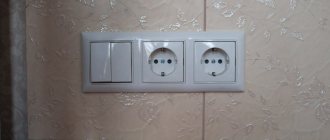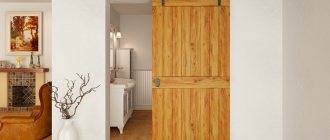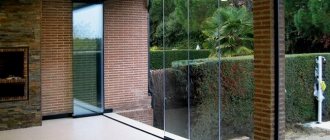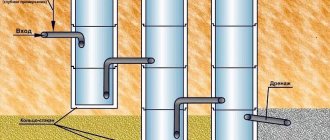The space of any room should be used 100% rationally, as conveniently and efficiently as possible. The placement of sockets for connecting electrical appliances is of great importance for this.
Standard electrical wiring is usually not enough. To avoid a large number of tees and extension cords, you have to install additional sockets
It is necessary to consider which electrical devices will be used simultaneously. So that extension cords do not interfere with cleaning, and you do not need to turn off the TV to recharge your phone, the location of sockets in the bedroom must be correct and the number must be sufficient.
Too much is better than too little. The presence of an unused outlet will not be noticeable, but the lack of even one will bring a lot of inconvenience.
Smart technologies: the new world of sockets
Bright colored outlets not only look good in children's rooms, they can also set new accents in the bedroom. This can be seen in design programs when preparing a design project: you can view a three-dimensional photo of a socket in the bedroom on the wall.
In addition, specific functions can be assigned to colored outlets. For example, you can install multi-colored sockets on the sides of the bed to connect reading lamps, sockets in the bedroom for a TV and for a computer.
Since the socket is used frequently, the feel also plays a decisive role: the surface must be pleasant. Therefore, in addition to ordinary plastic, there are also sockets with glass surfaces, as well as stainless steel or porcelain.
Sockets: where to put and how much to take?
First, sit down and together with the designer think about how many sockets you need to be happy. As a rule, such questions somehow fall out, get lost in the general list of what needs to be done. And after renovation, the apartment suddenly becomes overgrown with electrical extension cords, and even extension cords plugged into extension cords with splitters.
Draw a floor plan of the apartment along with the arranged furniture and household appliances. Think about where it would be convenient for you to connect this or that electrical appliance. Determine the height of the outlets and their distance from walls and windows. But first things first: let's go through the rooms, from the hallway to the toilet, and think together about how best to place the sockets.
Practical design of sockets in the bedroom
When planning a bedroom, the emphasis should be not only on the furnishings, but also on how to arrange the sockets in the bedroom. It is necessary not only to avoid annoying cable tangles, but also to create visual calm and a pleasant atmosphere in your bedroom. This is also confirmed by the elegant arrangement of the sockets in the bedroom and the discreet design of the socket, especially since the colors and materials used are perfectly adapted to the interior of the room.
Illuminated sockets not only create a practical power source, but also elegant lighting accents that also provide greater safety at night when searching for the switch.
A massive switch with socket and clearly visible cable routing maintains the industrial look of the room and shows how you can create stylish accents using original sockets.
Glass rosettes very delicately and discreetly fit into the overall picture of a stylish bedroom and give it additional elegance.
Particularly practical: the USB connector integrated into the socket in the bedroom ensures that your smartphone never runs out of charge and is always within reach.
How to choose and buy sockets for a children's room
Repair of a children's room must be carried out taking into account the location of the furniture, which determines the location of the installation of sockets for connecting various electrical appliances. Such fittings must comply with a number of rules that ensure comfortable use of the equipment. The dimensions of the room influence the choice of design of finishing materials and electrical wiring elements. Let's look at how to arrange sockets in the nursery.
Options
In order for the accessories to become indispensable, you must follow the rules:
- Safety. Since children like to be interested and explore the world around them, they may want to test the design of a switch or socket for strength. Such accessories for a children's room are available with additional equipment with a protection mechanism; this is an excellent solution for installation in a home with a child.
- Design. The main parameter for selecting fittings is compliance with the same style as the interior of the room. Therefore, it is better to purchase switches whose housing does not attract much attention from children. This helps children use the light switches less often to play. However, some designers recommend choosing an original design if the accessories are bright accents of the room's decor.
- Convenience. Manufacturers offer lines for silently turning on the light. This will ensure a comfortable rest for the baby, because clicking is inappropriate during sleep.
- An additional criterion for selection is the material. The type of polymer composition must be environmentally friendly and have a product quality certificate.
The design of this type of fittings is significantly different. For example, European manufacturers produce a wide range of products for children's premises:
- separate modules for connecting individual electrical appliances;
- combined panels, which consist of 3 sockets and a switch;
- block versions with several keys for adjusting different levels of lighting fixtures.
Types of electrical modules for children's rooms
A closed socket is an ideal type of design for installation in areas where small children live. The technical equipment of most special access protection units for children is distinguished by the presence of special curtains that block access to plug connectors.
Installation of hidden electrical wiring
The uniqueness of the device is that the limiters are built into the body. If you are interested in this topic, then here, if you wish, you can find out more or, for example, buy sockets https://www.toledonn.ru/. The advantage is that they do not require independent additional modernization; this is the optimal solution for parents.
Certain modifications are capable of automatically closing the nests. It is possible to equip standard modules with such elements, but this is quite difficult. This requires the installation of removable curtains into a classic socket block. They also prevent access to electricity by automatically closing the connectors. The reliable type of design protects the child from playing with electrical appliances.
Another type of fittings is equipped by the manufacturer with additional panel covers. They limit the free connection of equipment, as well as other items, to the electrical network. Such sockets are practically no different in decor from ordinary ones, so they can additionally be placed in other rooms of the house where the child is.
A popular, but less reliable way to prevent children from accessing an outlet is to install plugs. Over time, children learn to remove such blockages. More modernized versions are the same elements with a lock. It is impossible to dismantle such plugs without a real key. It is important to note that such mechanisms must be closed independently to block children’s access to electricity in the room.
How to properly place sockets and switches?
- General lighting switch.
As a rule, this wiring element is installed 0.75-0.9 m above the floor covering. When determining the level of accommodation, it is necessary to take into account the average height of all family members. The installation location should be convenient for pressing the switch by simply moving your free hand to the side. At the electrical wiring design stage, it is also advisable to determine the placement of cabinets so that they do not overlap the keys. The direction in which the interior door opens is also important; the module should be installed on the side where the closed door handle is located. - Additional power supply module in the entrance area. Typically, the height of sockets in a children's room is 30 cm. This module is placed at a distance of 10 cm from the doorway. It is usually used for vacuum cleaners, heaters and other equipment.
- Blocks for electrical appliances near the bed.
Such sockets are used to operate a humidifier or night light. Therefore, they are installed at a height of 15-30 cm. - Sockets at the desktop. Near this space for drawing and studying, it is necessary to provide connectors for connecting a computer and a table lamp, additional ones if necessary. For additional gadgets, it is also necessary to install separate sockets. Such blocks are installed 15 cm above the tabletop level.
Arrangement of electrical sockets
Depending on the parameters of the children's room, to use conventional electrical appliances you will need to install 5-7 power outlets and one switch.
Conclusion
By considering how to arrange sockets in a children's room, it is possible to create optimal conditions for the development of children. The given recommendations for choosing the type of protective mechanisms allow you to determine the costs of such modules.
The design of modern fittings for children's rooms comes in a wide variety from European manufacturers who produce specialized lines of electrical products.
Among domestic companies, the most commonly found in stores are blocking curtains for self-installation and plugs in various variations. With their help, you can make sockets for the children's room yourself.
Related posts:
Source: https://ehto.ru/montazh-elektriki/rozetki/kak-vybrat-i-kupit-rozetki-dlya-detskoy-komnaty
Socket as a night light
Outlets today offer possibilities beyond a pure power source. There are hidden sockets that are equipped with LED lighting, so that the socket is visible even at night.
Sockets with LED lighting, such as a USB charging station or Internet connection, are available as conventional flush-mounted solutions.
Kitchen
In terms of the number of electrical appliances per unit area, the kitchen will give odds to any room. Let's just count: refrigerator, electric stove or gas stove, but with electric ignition, oven, hood over the stove, microwave, electric kettle. And these are only those devices that are constantly connected to the network. Plus, a washing machine and dishwasher can live in the kitchen.
In addition to them, there is also a mixer, blender, coffee grinder and coffee maker, electric meat grinder and juicer, pancake maker, sandwich maker and a bunch of all sorts of appliances that are taken out and turned on regularly. Let’s count again: for those who are always on, it’s eight, and at least five is needed “just in case.” Therefore, the question of how to properly place rosettes in the kitchen has its own technical nuances.
Appliances
Connectors for the refrigerator and stove can be located directly behind them: how often do we rearrange our kitchen? Turned it on and forgot it. If your microwave is on the refrigerator, and this often happens, its point is there - behind the refrigerator. The same applies to the washing machine and dishwasher: connectors for them, as a rule, are hidden behind the kitchen unit.
Many people do not know where to place the outlet for a constantly switched hood. In our opinion, the most suitable place is under the ceiling. If you are going to use an electric stove and an electric oven, they will need separate, thicker gauge wiring.
Additional equipment
It is convenient to plug small and infrequently used equipment into the connectors located above the worktop. It is convenient to use two groups of three: many designers offer their clients exactly this arrangement. Another option is to build them into the countertop.
Socket as USB charging station
There is also a smart solution for many power-hungry mobile devices such as cell phones, MP3 players or tablets: instead of the classic socket, the USB charging station can be installed as a flush-mounted unit.
The built-in power supply allows you to charge multiple mobile devices in one place.
And further…
All this, of course, at first glance is understandable and seems to be uncomplicated. It seems like you can handle it yourself. And it’s true: buy a screwdriver, pliers, a couple of rolls of cable, and your new homemade electrician is ready.
You can google a couple more articles on the topic “how to plug in sockets correctly.” Draw a diagram and plug in all the sockets, saving some money on the designer, planner and professional team. But you probably already have an idea of what will come of it. By the way, the fire service number is 101.
Internet via Wi-Fi socket
Smart technology turns even a power outlet into an Internet connection if the wireless LAN range is limited by steel beams, walls, ceilings or other electrical devices in the house. A network connection can be established as a hidden solution via a Wi-Fi socket.
Data is transmitted over a regular electrical network, so there is no need to install new cables. Security is also ensured: data transmission can be securely encrypted using special software.
Why is this necessary?
According to rough estimates, at least 6 household appliances are used per day in each apartment. This number is constantly increasing, but the number of electrical outlets remains unchanged, so it is important to properly plan their location. If power points are installed randomly in the house, you will have to turn off some devices to charge others. This leads to inconvenience of use and the risk of increasing the maximum power for which the mechanism is designed and causing damage to the connected device.
When planning a room yourself, you need to understand its purpose, what devices to use and how to be located. The arrangement is carried out taking into account technical standards.
Socket for work in the bedroom
Are you planning a work area in your bedroom? Do you need a table, nightstand or even two? If you want to integrate a desk or work area into your bedroom, you need to make sure there are enough outlets.
A desk with built-in socket, a reading light right above the head of the bed or a practical power connection right in the center of the room: new socket designs combine universal practical functions and make endless cable clutter a thing of the past.
Corridor and hallway
In the corridor or hallway, two or three pieces will be enough. Most often they are used to turn on a shoe dryer. Therefore, do not raise the connectors too high. Of course, there is no need to hide them behind a hanger or behind the door; it is best to place them in the corners. It is better to turn on wall lamps directly, through a separate switch connected to the mains.
Socket: electrical installation update
Outlets in the home serve an important function when it comes to connecting and turning on electrical devices such as lamps. For this reason, it is important that residents generally assume that switches and outlets are functional. Therefore, it is important to update these technical means at intervals of 10 to 20 years.
If the switch, receptacle and other electrical systems are not regularly repaired, safety issues can arise and, in the worst case scenario, even fire damage to components or parts.
Principles for placing electrical accessories: bedroom and children's room
Previously, we already managed to tell readers about how it is necessary to place sockets in living rooms and home offices to make them convenient to use. Today we will devote time to premises that are often less loaded - the number of electrical consumers and the number of people operating them. As in previously discussed cases, it is important to maintain a balance between comfort, safety and acceptable appearance of electrical points.
At the very beginning, it should be noted that the premises analyzed today are much more subject to detailed zoning of space and division into independent functional areas than others. This will concern not only the installation of sockets, but also the positioning of lamps, as well as the placement of switches in places where they will be most convenient for consumers. Depending on the size of the rooms and the useful volume inside them, the overall concept of lighting and power supply can change significantly, becoming completely different from the electrical wiring that is done in many other rooms.
Sockets: repairs are possible without much effort
Many homeowners shy away from repairing bedroom outlets and switches as part of the electrical system because it involves extensive construction work. In many cases, it is completely unnecessary to open all the walls.
As an alternative, for example, skirting boards and ceiling profiles are available into which ready-made installations can be installed. In this way, construction measures can be significantly reduced, which is also interesting from a cost point of view.
Step-by-step instructions for installing and connecting the socket
- The decorative panel is removed;
- The bolts are loosened;
- The glass (mounting) is installed in the wall hole and fixed. Zero and phase are neatly brought out;
- The housing is inserted and secured in the holder with screws;
- When connecting bare parts of conductors to terminals, polarity is not taken into account;
- The last step is to install the cover and turn on the automatic device to check the operating condition of the outlet.
It is very easy to install the overhead model by simply securing it in place of the socket box.
Location of sockets
The height of sockets in the bedroom and the position are usually well thought out. Standards and regulations ensure that most electrical connection options can always be found in the same place.
If you are looking to upgrade or expand your existing installation yourself, you should know as much as possible about these standards and regulations so that you know at what height bedroom sockets can be installed.
Abroad, the height of sockets for a TV in the bedroom, for lighting a workplace, for an iron is 140 cm from the floor. Bedside sockets in the bedroom are located at a height of 60 cm, and sockets above the bedside table in the bedroom are located at a height of 15 cm from the height of the bedside table.
It is necessary to pay attention to the sockets for the TV in the bedroom: their height may depend on the wishes of the client, on the location of the TV, on the height of the bed on which they will watch TV. Therefore, the height can be from 130 to 140 cm.
Before the bed is in the bedroom, check where the outlets are located. Particularly in older buildings, an electrician may have to be called in again to install additional sockets, so it's important to know at what height to install sockets in the bedroom. The bed and closet should not directly cover the sockets.
Installation differences
Sockets according to the installation method are divided into two types: built-in and surface-mounted.
- Built-in sockets do not have a housing and are installed in a mounting box.
- The word “overhead” speaks for itself: devices of this type have a housing, and it can be of various shapes. Installation is carried out on a surface made of non-combustible material.
- When selecting a product, you should pay attention to how the pins of the plug are held in the sockets of the socket: the connection must be very tight.
- It is worth considering such a parameter as the degree of protection from dust and moisture. It is indicated by the IP symbol with a series of numbers from 25 to 70. For ordinary rooms, IP20 protection is quite suitable; for rooms with high humidity, it is desirable that it be higher.
- Very convenient products are equipped with a special device that, when you press a button, will automatically push out the plug: such a contact group will last longer.
Block systems are practical when there are several different connectors in one housing - for example, for connecting a telephone, cable TV or computer.
Outlet: Comfort is also important
In addition to safety issues, comfort issues also play a role. For example, you need to check whether there are a sufficiently large number of sockets in the bedroom. Sockets can only be used comfortably if there are enough connection options for each situation.
It is recommended to use several sockets in the bedroom. The bedroom should have outlets with four or six connections, as long as there are connections for lights, telephone, computer, music system and TV. This eliminates the need to frequently connect devices.
It is important to remember that sockets in the bedroom near the bed should be located at least 30 cm from the pillow.
Socket at the dressing table
An outlet near the dressing table is necessary to connect a hairdryer and other electrical appliances that are extremely necessary for every woman and whose purpose is understandable only to them. The matter is rarely limited to one “point” - usually a block of two to four sockets is mounted. In any case, they are located several centimeters above the level of the tabletop.
In some cases, they are used “multifunctionally” - to connect the same vacuum cleaner, for example... in such cases, the power line of these electrical installation products must be designed for the appropriate load.
Electrical emissions from outlets
People react differently to electromagnetic radiation. Women, in particular, seem to be more "electro-sensitive". That's why many are calling for lower limits, especially for bedrooms. The fact is that radios, cell phones, telephones, televisions, routers, computers, outlets, extension cables and even hidden power lines generate radiation. The fewer devices and cables in the bedroom, the more beneficial it is for healthy sleep.
When our body recovers during sleep, we draw new strength from rest. Therefore, in the bedroom it is important to avoid anything that can disturb your night's sleep. In particular, electricity planning plays a role that cannot be underestimated.
Electrical radiation and electromagnetic fields can interfere with our sleep. This applies to everything near the bed: less is more. But most buyers don't ban TVs and computers in the bedroom. If possible, avoid sockets and cables near the bed.
What is an Electrical Wiring Plan?
In cases where home renovations are carried out by a professional company, their services necessarily include a wiring drawing . But coming up with a bedroom design and developing a plan yourself is a very interesting activity, and does not require specific knowledge. But your own bedroom design allows you to think through every little detail in the room and bring your ideas to life.
By creating a wiring plan, the future lighting of the bedroom is determined. Therefore, you first need to think about the future interior of the room. When the location of the bed, bedside tables, and electrical appliances in the bedroom becomes clear, you can begin planning the placement of sockets.
It is advisable not to make too many sockets, which will then remain in the wall unused. But too little will result in extension cords trailing across the floor.
Here the question may arise why the house builders did not think through the convenient location of the outlets in advance. The fact is that the convenience of the location of switches and sockets depends on the purpose of the room. When thinking over an electrical plan for a bedroom, you should take into account not only the number, but also the height of the sockets. It should be convenient for a person to turn off the light without getting out of bed, or the bedside table should not interfere with charging a mobile phone.
Measures against electrical radiation in the bedroom
If you want to completely disconnect your bedroom from the power supply at night, you can easily do this by installing a mains disconnect switch. It interrupts the mains voltage at the fuse box until electricity is required.
As soon as the consumer is turned on again, the supply voltage is automatically switched back to the line without delay. In everyday life, these network outages are not noticeable.
Bathroom and toilet
In houses that were built more than thirty years ago, such electrical communications in the bathroom and toilet were not provided at all. People had never even heard of such miracles as a Jacuzzi or a shower stall, so no one asked themselves the question of how to place sockets in the bathroom.
Some craftsmen independently pulled wires into the bathroom, attached connectors into which they plugged in a Kharkov electric razor or hair dryer. Today everyone knows about these miracles, they are all accessible and pleasant. Therefore, when designing a bathroom, you need to immediately look at places for sockets.
Important:
- All switches and other electrical equipment must comply with the standard for electrical equipment for wet rooms (protection class no less than IP44) and be reliably grounded. The designer or planner should definitely tell you about this
- The socket for the Jacuzzi and shower can be installed behind their decorative walls; you will not constantly turn these units on and off
- The socket for the exhaust fan can be installed at the top, next to it, although most often the exhaust fan is connected to the lighting system: turn on the light - the fan hums
- You can mount one or two points near the bathroom mirror, which usually hangs above the washbasin. One can be used to power the lights above the mirror, the second for a hair dryer, razor and other small appliances. Naturally, we remember about the protection class and grounding
- If the dimensions of the bathroom allow you to install a washing machine, remember that the connector for it is located at a distance of at least 50-60 cm from the water pipes











